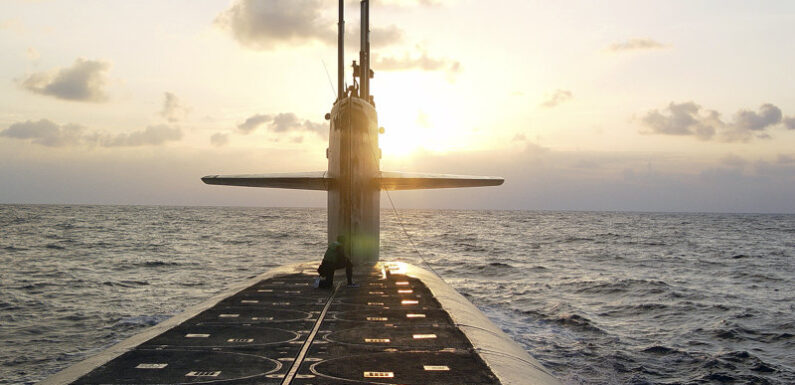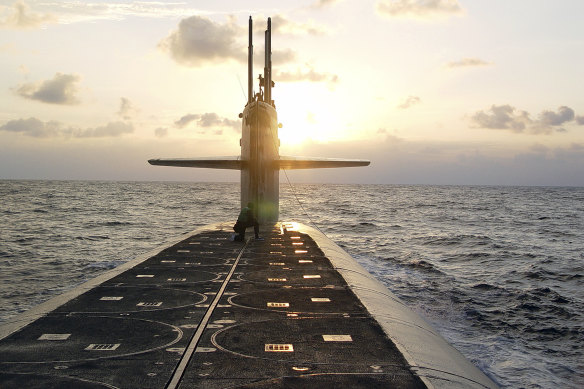
Save articles for later
Add articles to your saved list and come back to them any time.
On 5 November, a US military headquarters made an unusual announcement.
“An Ohio-class submarine arrived in the US Central Command area of responsibility,” the Command told the world, accompanying the brief statement with a picture of the submarine in the Suez Canal, which is where a US warship ceases to be under European Command and comes under Central Command, aka CentCom.
The US Navy may be tapped to provide the majority of the subs initial crews.Credit: AP
The US doesn’t normally publicise its submarine movements, so the announcement is unusual. The submarine is also unusual: it’s one of just four SSGNs, nuclear powered guided-missile submarines, in the US Navy.
The four SSGNs were made by taking a normal Ohio-class SSBN, a nuclear powered deterrent submarine armed with nuclear intercontinental ballistic missiles, and removing the Trident ballistic missiles. Many of the Trident launch cells are replaced with multi-shot canisters containing conventionally-armed Tomahawk cruise missiles, giving the submarine a formidable arsenal of over a hundred powerful weapons able to strike targets afloat or ashore over a thousand miles away.
Also interestingly, some of the vacated Trident space is used to create “lock out chambers”, airlocks which permit divers to leave the submarine under water. It’s also possible to fit the submarine with a “dry deck shelter”, a small docking bay in which a mini-submarine can be carried. This means that the mother sub can remain undetectably submerged offshore in deep water and send frogmen in to make a landing without anyone seeing them by eye or radar until they emerge on shore. The SSGN which transited the Suez Canal had such a DDS fitted.
SSGNs also have extra accommodation allowing them to carry 60+ special forces operators for sustained periods of time, or 100+ for shorter periods. These special operators naturally need to be divers to operate from the sub, so they would normally come from the US Navy’s elite SEAL teams.
Ohio class SSGNs, being originally built as deterrent boats whose primary mission imperative is to remain undetected, are very silent and stealthy. Even a first-class anti-submarine warfare task force from one of the world’s major navies would struggle to find that submarine now that it has exited the Canal and submerged again: the Iranians and their Houthi pawns in Yemen have no chance.
Very few people know what the submarine and the SEALs’ mission is: it may be merely to take up position in case of an emerging need. Sending it through the Canal, however, suggests an urgent requirement. And given that the submarine’s transit through Suez would inevitably become known to hostile intelligence services, it makes sense to announce it to the world if only for morale effect.
Certainly, if I were a member of the Houthi rebel movement, perhaps engaged in launching missiles and drones at Israel, I would be reluctant to hang about anywhere near the sea right now.
Lewis Page is a former Royal Navy diving officer.
Telegraph, London
Get a note directly from our foreign correspondents on what’s making headlines around the world. Sign up for the weekly What in the World newsletter here.
Most Viewed in World
From our partners
Source: Read Full Article
